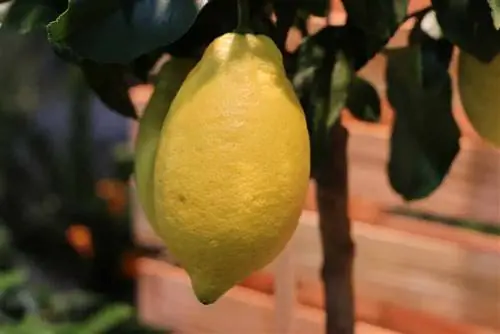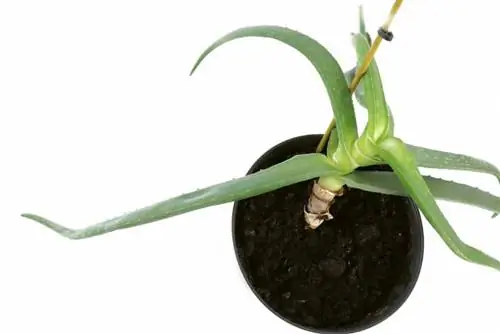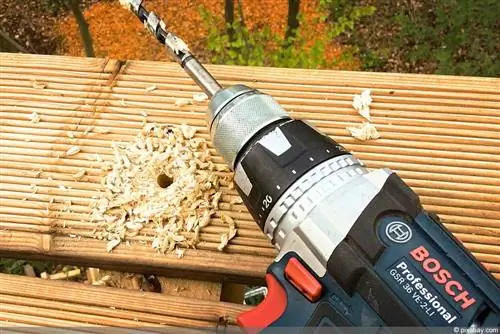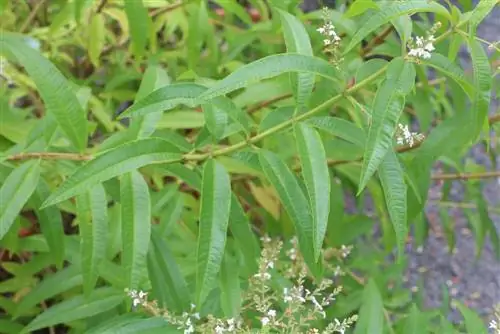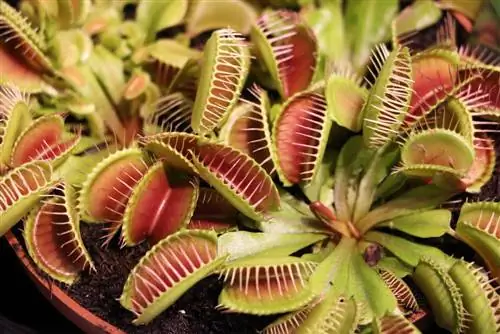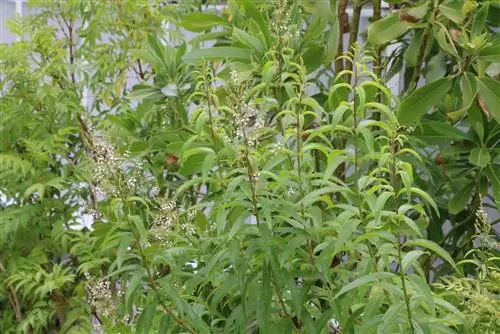- Author admin [email protected].
- Public 2023-12-17 03:39.
- Last modified 2025-06-01 06:48.
Harvesting lemons for homemade lemonade is easy with your own lemon plant. However, it must also be cultivated accordingly. If you pay attention to a few points, especially when it comes to location and substrate, you won't have any problems with it. Because lemon plants are comparatively undemanding and are therefore ideal for beginners in plant care.
Location
The ideal location for lemon plants is:
- warm
- sunny
- protected from wind and drafts
For example, places near the window, the winter garden or, in summer, a sheltered place on the balcony or in the garden are suitable. Above all, care must be taken to ensure that the lemon is not drafty and that it receives as little cold wind as possible, even when ventilating.
Substrate
The substrate for the lemon plant must be permeable and able to store water moderately. The soil should also be slightly acidic. A pH value between 5.5 and 6.5 is optimal. Since lemons are somewhat demanding and picky when it comes to the substrate, it is not recommended to mix the soil yourself. It is better and easier to use special citrus soil or citrus plant soil from specialist retailers.
Plants
Although the lemon plant can be grown outdoors in summer, planting it outdoors does not make sense. It is better to culture it in an appropriate, stable bucket. Since the smaller cultivars Citrus Limon Meyer and Citrus Limon Ponderosa reach heights of less than one and a half meters, the planter does not have to be too large.
Pouring
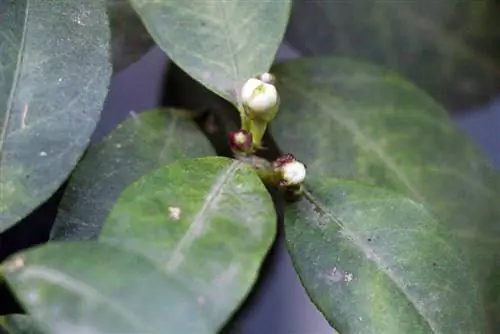
The lemon plants are frugal when it comes to watering. Watering is only carried out again when the upper layer of soil has dried out. Waterlogging or permanently moist soil must be avoided, as the lemon reacts very sensitively to this. If the small tree bears fruit, the water requirement is increased. The following are well suited for watering:
- Rainwater
- untreated pond or aquarium water
- stale or filtered tap water
Lime - and therefore hard water - is not a problem for the lemon in small quantities. However, if possible, it should not be used every time you water, as it can influence the pH value of the substrate and cause the soil to become too acidic.
Tip:
The water should, if possible, be at room temperature and drain easily. It therefore makes sense to have a drainage layer made of gravel or expanded clay at the bottom of the bucket.
Fertilize
From spring to late summer, lemon plants are fertilized every two weeks. During wintering, a light application of fertilizer every four to six weeks is sufficient. However, the additional nutrient supply can then be completely stopped if the lemon is kept cool over the winter. A special citrus fertilizer from specialist retailers is recommended. To ensure that the concentrated nutrients do not cause chemical burns to the roots, fertilization should always be combined with watering.
Intersection
The trimming of the lemon plants is not absolutely necessary, but it can fulfill two functions. On the one hand, it stimulates fruit formation and, on the other hand, it helps to keep the plant compact and limit its height. The optimal time for cutting is in spring, when buds or even fruit can already be seen. Then individual shoots can be cut without reducing the yield.
Please pay attention to the following points:
- use clean cutting tool
- Intersect shoots that do not have buds, flowers or fruits
- Short branches by about a third of the total length
If you have poor eyesight, you can also measure the shoots of small lemon plants with a ruler before cutting.
Twigs that are damaged or dried out should also be trimmed. With these, the cutting can and should be more radical and can start directly at the connection to the trunk.
Propagate
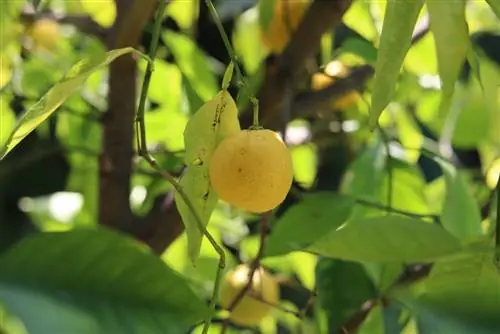
Anyone who has caught a particularly juicy and sweet lemon often has the plan to use the seeds to grow new plants and thereby provide themselves with lemon plants and fruits. This is theoretically possible with commercial lemons, but unfortunately it doesn't work as desired. Because these are the seeds of large lemon trees. These are very unsuitable for the winter garden or the living room.
The situation is similarly unfavorable with fruits or seeds of the small species. Although young plants can be grown from the seeds, this cannot guarantee foreseeable and successful lemon cultivation. The following problems and limitations are responsible for this:
- not all lemon plants grown from seeds bear fruit
- it takes several years before fruit can be expected at all
- Plants grown from the seeds of lemon plants can produce different fruits
It is therefore better to purchase a grafted lemon plant. If you still want to try propagation by seeds, you can proceed as follows:
- The seeds are removed from the pulp and washed thoroughly.
- Each seed is placed individually on growing soil and covered by one to two centimeters with the substrate.
- The substrate is slightly moistened on the surface with a plant sprayer, but should not be dripping wet.
- The cultivation containers are placed in a bright, warm location that is not exposed to direct, blazing sun. A window sill facing east or west or a place near a window - but not a window sill - towards the south is well suited.
- In order to keep the substrate moist and create a protected climate, the cultivation containers should be covered with a glass plate or a transparent film. Daily ventilation prevents mold from forming under the cover. A simpler alternative is to use a houseplant.
- When the young plants are five to ten centimeters high, the cover can be removed. You can also change to citrus soil.
Freeland
As mentioned, lemon plants can spend the summer outdoors. This is even recommended, as experience shows that it makes them more resilient. It is important that they are protected from the wind, warm and sunny. They should also be brought indoors when temperatures drop below 15°C. In warm regions they can be left outside during the day as early as spring. However, when temperatures drop at night, the lemon plants must be brought indoors.
Wintering
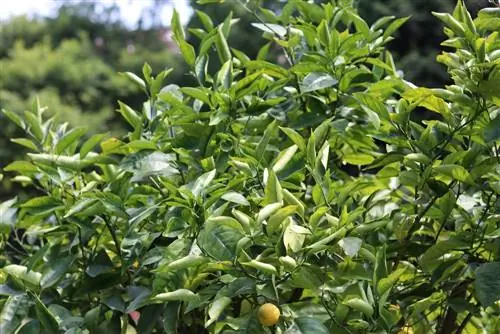
Lemon plants can stay warm all year round, but it makes more sense to have a rest period in winter. This is achieved by moving the plants to a bright location where the temperature is 10 to 15 °C. Unheated stairwells, winter gardens or well-insulated garages can be suitable for this. If you don't have a suitable place to overwinter your lemon plants, you can have them professionally overwintered in a nursery.
In addition to the location, the following points are also important:
- continue to water so that the soil does not dry out completely
- If ripe fruits are still present, they should be removed - in many cases, unripe lemons continue to ripen on the plant even over the winter
- Stop fertilizing during the cool winter; if the winter is warm, increase the intervals between nutrient applications to four to six weeks
Bucket Culture
Since lemon plants cannot be planted outdoors in temperate climates, pot cultivation is a given - but some factors should also be taken into account.
This includes:
Drainage
The already mentioned layer of gravel or expanded clay at the bottom of the pot prevents the roots from standing in water - if too much is watered. The drainage also promotes the flow of water out of the earth.
Better coaster than planter
If the planter is in a planter, excessive watering is not always immediately noticeable. Despite drainage, waterlogging can occur and mold can develop. It is therefore better to use a saucer for sensitive lemon plants. This also makes it easier to check whether the roots have already reached the bottom of the pot and whether a pot change is necessary.
Bucket size
Lemon plants form taproots. This means that their roots grow deeper rather than wide. The bucket should therefore be as high as possible, but can be rather narrow. Its diameter can be selected when repotting depending on the size of the root ball.
Repotting
Repotting is only rarely necessary for lemon plants. It only becomes necessary when the roots have reached the bottom of the bucket. Even then, it is sufficient to choose a new planter that is only about two to four centimeters larger than the previous pot.
The procedure is as follows:
- The citrus plant is carefully removed from the old bucket. The substrate can be easily tapped and shaken off. To remove solid residue, the root ball can also be rinsed or showered with little pressure.
- A drainage layer and some citrus plant soil are placed in the new bucket. The soil should be filled so high that the root ball is only a few centimeters below the edge of the pot. The pot is now filled all around with the substrate.
- So that the soil is optimally distributed, the bucket is gently shaken again and again while it is being filled. Finally, it is pressed down with little force. This way there are no cavities between the roots.
- After repotting, the lemon should be watered.
Typical care errors & illnesses
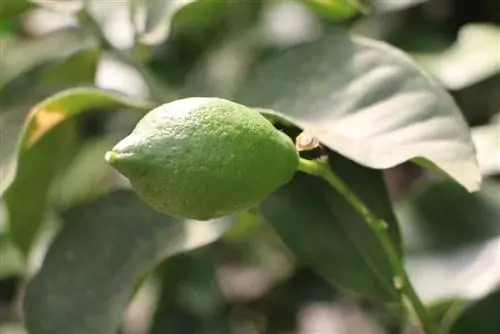
Care errors are not uncommon for lemon plants and can cause diseases as well as pests. Typical care errors include:
earth too wet
Excessive watering and waterlogging can lead to root death, mold and fungal infections. Even changing the substrate and using appropriate antifungal agents cannot always guarantee the survival of the plant.
earth too dry
If watering is too sparing, nutrients from the substrate cannot reach the shoots. The result is usually a fall of leaves due to drought damage. If the watering is repeated, the lemon tree could sprout again.
incorrect fertilization
Too often, too rarely or the wrong product - errors in fertilization can lead to under- or over-supply. Signs of this include yellowing leaves, falling foliage and stagnant growth.
unfavorable wintering
If the lemon is too warm and too dark during the winter, the risk of drought damage and falling leaves increases.
Pests
In terms of pests, lemon plants are particularly susceptible to lice.
Below:
- Scale insects
- Aphids
- Mealybugs or mealybugs
- Spider mites
Optimal cultivation conditions and occasional cleaning of the leaves reduce the risk of pest infestation. If there is already an infestation, depending on the type of parasite, it can be combated by spraying with a solution of soft soap and water and then rinsing thoroughly with clear water - or an appropriate product from a specialist retailer. If it is spider mites, the plant is showered or sprayed with water and then covered with a plastic bag for a few days. Increasing the humidity does not affect these pests. It is important to combat the pests quickly as they weaken the plant and can also promote fungal infections.
Tip:
To prevent diseases and pests, the leaves of lemon plants should be checked regularly. An infestation or changes can be detected early and treated better.

